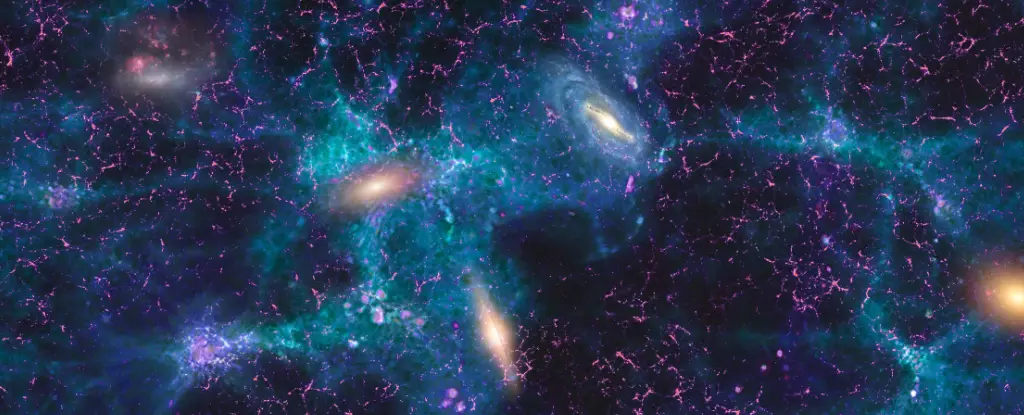The universe, an awe-inspiring expanse that continues to unravel its secrets, presents an ongoing challenge to cosmologists. Recent studies have indicated that the fabric of space around us seems to be expanding at a rate that defies existing physics models. Using meticulous measurements of a galaxy cluster located over 300 million light-years away, scientists are beginning to confront a fundamental issue that may redefine our understanding of the cosmos.
For decades, astronomers have constructed a rudimentary model of the universe, one that explains its beginnings as an extraordinarily dense concentration of mass and energy. This accumulation ignited the expansion of the universe, leading to a dispersal of galaxies akin to boats drifting on a vast, empty sea. Yet, beneath this simplified narrative lies a complex interplay of forces that challenge our understanding, including enigmatic phenomena labeled as dark energy and dark matter. While some components can be quantified, much remains obscured by our limited grasp of quantum physics and gravitational forces.
As we grapple with the forces at play, the prevailing theory of an expanding universe is juxtaposed against a consistent pattern where matter clumps into visible structures, interspersed with regions of the impossible-to-see dark energy. This duality culminates in the Hubble constant, which quantifies the rate at which galaxies recede from one another. Traditionally, astronomers have measured this receding speed using various methods, yet these techniques have yielded conflicting results, igniting tension among scientists—a tension evolving into what some refer to as a crisis.
Dan Scolnic, a prominent physicist at Duke University, and his team embarked on a mission to clarify disparities surrounding the Hubble constant. Their study leveraged data obtained from the Dark Energy Spectroscopic Instrument (DESI), which previously measured the relationship between the expansion of space and distances to specific galactic clusters. The focus of their effort was the Coma cluster, harboring over 1,000 known galaxies and located at an impressive distance.
Through intricate analysis of light emitted by Type Ia supernovae—celestial explosions recognized for their consistent brightness—Scolnic and his colleagues arrived at a refined distance for the Coma cluster: 321 million light-years. This figure aligns closely with previous estimates, adding a layer of credibility to their calculations. Accurate measurements of cosmic distances are vital, setting the stage for building a cosmic distance ladder that connects measurements of near-space phenomena with those farther out in the universe.
Their findings indicated the universe is expanding at a remarkable speed of around 76.5 kilometers per second per megaparsec. Nonetheless, this number clashed sharply with older cosmic data drawn from remnants of the early universe, specifically the cosmic microwave background radiation, which suggested a slower rate of 67.4 kilometers per second per megaparsec. This divergence encapsulates one of the most enduring puzzles in modern cosmology.
The stark contrast between these measurement methods raises critical questions. Why does a substantial discrepancy exist between two independently-derived calculations? Addressing this enigma could either reveal a foundational miscalculation in our existing frameworks or unveil novel aspects of physics that await contemplation.
As Scolnic notes, “We’re at a point where we’re pressing really hard against the models we’ve been using for two and a half decades.” This statement epitomizes the urgency in the field; cosmologists are compelled to refine their methodologies, seeking to bridge gaps that have persisted lor longitudinal periods. Each approach to measuring the universe’s expansion might be tugging at the fabric of reality itself, challenging established paradigms and nudging scientists toward a deeper understanding of the cosmos.
As humanity continues to probe the mysteries of the universe, resolving the discrepancies in the Hubble constant is essential. The pursuit is not merely academic but pivotal in constructing a coherent narrative about the universe’s structure and ultimate fate. At this frontier of knowledge, scientists stand on the cusp of either reaffirming established theories or dramatically reshaping our conception of the universe.
In the coming years, advancements in technology and theoretical physics may bring clarity to these cosmic puzzles. Until then, the rift between the measured rates of expansion serves as a reminder of the vast unknowns lingering in the heavens, beckoning us to explore deeper and with greater curiosity than ever before.


Leave a Reply